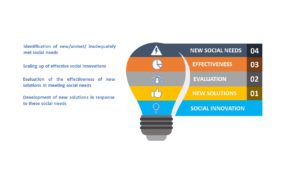Social Innovation
 “In the eighties and nineties, the innovation agenda was exclusively focused on enterprises. There was a time in which economic and social issues were seen as separate. Economy was producing wealth, society was spending. In the 21st century economy, this is not true anymore. Sectors like health, social services and education have a tendency to grow, in GDP percentage as well as in creating employment, whereas other industries are decreasing. In the long term, an innovation in social services or education will be as important as an innovation in the pharmaceutical or aerospatial industry.”
“In the eighties and nineties, the innovation agenda was exclusively focused on enterprises. There was a time in which economic and social issues were seen as separate. Economy was producing wealth, society was spending. In the 21st century economy, this is not true anymore. Sectors like health, social services and education have a tendency to grow, in GDP percentage as well as in creating employment, whereas other industries are decreasing. In the long term, an innovation in social services or education will be as important as an innovation in the pharmaceutical or aerospatial industry.”
Diogo Vasconcelos (1968-2011)
Senior Director and Distinguished Fellow with Cisco’s Internet Business Solutions Group
Chairman of SIX – Social Innovation Exchange
What is Social Innovation?
In the research literature there are different approaches to defining the concept of innovation. One of the most known authorities on innovation theory Rogers (1983, 1995, p.11, 2003) defined innovation as ‘an idea, practice, or object that is perceived as new by an individual or other unit of adoption’. This view relies on individual perspective. Carayannis, Gonzalez and Wetter (2003, p. 118) propose to classify the concepts of innovations according to four dimensions:
1. the process of innovation – the way in which an innovation is developed, diffused and adopted;
2. the content of innovation – technical or social nature;
3. the context of innovation – the environment in which the innovation is emerges and is developed;
4. the impact of innovation – social or technological change that results from innovation.
Social innovation can be defined as the development and implementation of new ideas (products, services and models) to meet social needs and create new social relationships or collaborations. It represents new responses to pressing social demands, which affect the process of social interactions. It is aimed at improving human well-being. Social innovations are innovations that are social in both their ends and their means. They are innovations that are not only good for society but also enhance individuals’ capacity to act.
They rely on the inventiveness of citizens, civil society organizations, local communities, businesses and public servants and services. It is are an opportunity for the both, public sector and for the markets, so that the products and services better satisfy individual but also collective aspirations. Stimulating innovation, entrepreneurship and the knowledge-based society is at the core of the Europe 2020 Strategy.
Social innovation describes the entire process by which new responses to social needs are developed in order to deliver better social outcomes.
This process is composed of four main elements:
 In sum, successful social innovations should be culturally acceptable, economically sustainable and technologically feasible.
In sum, successful social innovations should be culturally acceptable, economically sustainable and technologically feasible.
For further information about EaSI and Social Innovation, please contact us.








